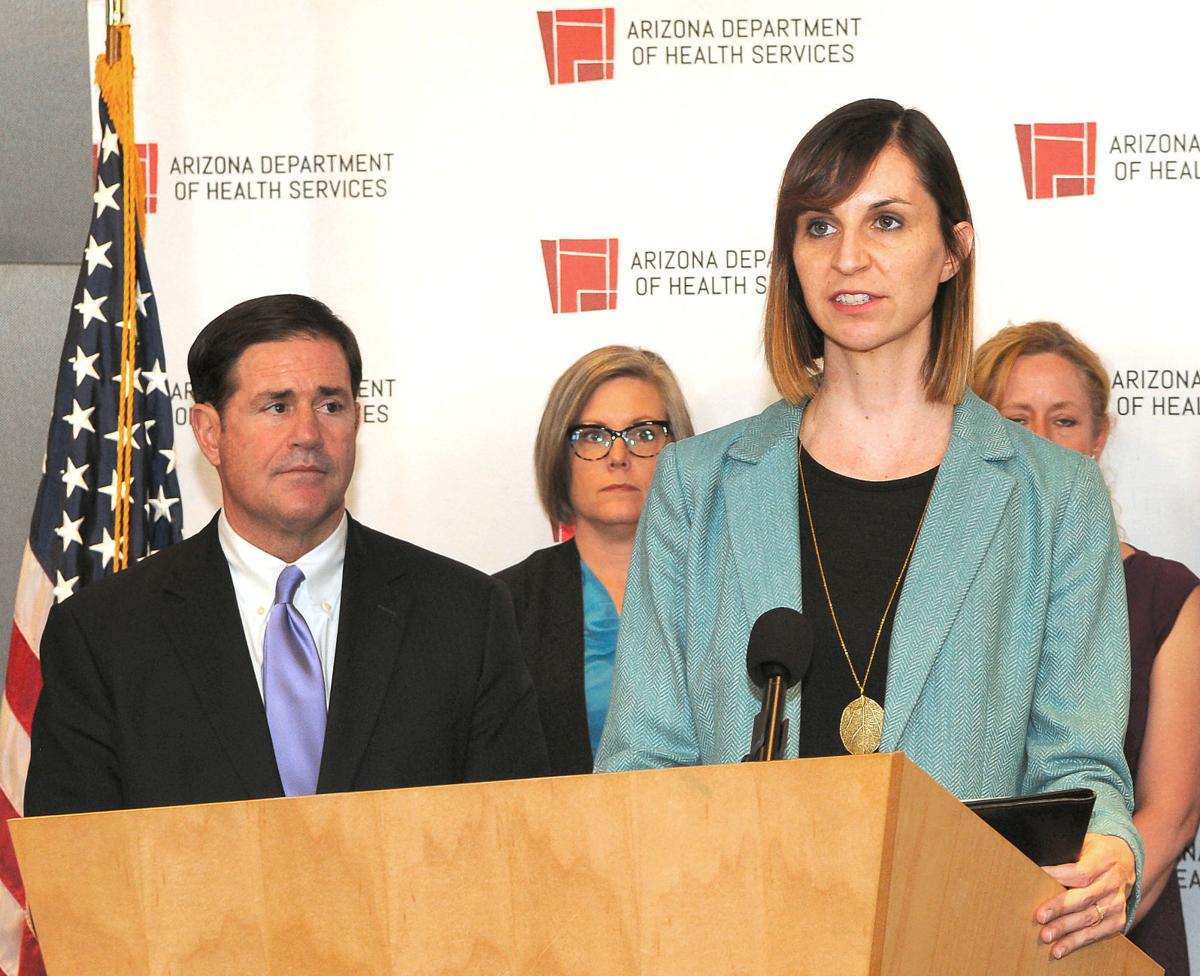PHOENIX — A two-week delay in the start of in-classroom learning ordered by Gov. Doug Ducey may give schools more time to prepare to teach in the middle of the pandemic.
But that assumes students — and teachers — are going to show up at school in August.
“A lot of parents are ready for their kids to go back,” said Joe Thomas, president of the Arizona Education Association. And he said teachers also are ready.
But Thomas said it’s not that simple in the days of COVID-19.
“We’re all starting to learn that there are people that we know who either they have it, or their kids have it or a family member has it,” he said of the coronavirus.
“So there’s a lot of anxiety,” Thomas explained. “They want to be back. But they just don’t feel safe.”
Even Arizona schools chief Kathy Hoffman said there’s no guarantee that there will be children in classrooms, or that it will be safe to open schools on Aug. 17. Instead, Hoffman says she expects that date will be when education officials will evaluate conditions at that time.
“And there is a potential for that date to shift,” Hoffman said.
It all might come down to how extensive COVID-19 infections remain in the state, said Chris Kotterman, a lobbyist for the Arizona School Boards Association.
“We don’t know any better than anybody else what the numbers are going to look like,” he said. But the issue, said Kotterman, is even more basic than that.
“We do know that we have a lot of school staff who had expressed a lot of concern about coming back into the classroom when the numbers are so high,” he said.
Hoffman agreed, saying any final decisions will have to be based on whether parents are willing, and ready, to send their children back into classrooms.
“We have seen and heard directly from families and also from teachers and school staff this growing sense of anxiety and fear about returning to the school setting,” she said.
Hoffman said some districts already have been sending out surveys to both parents and staffers to find out if they’re ready to be in a classroom setting.
“I think that’s going to continue to be a challenge,” she said.
“It’s really hard to address those emotions because the COVID-19 virus is with us for now,” Hoffman said. “We don’t know when we’re not going to be living under these circumstances.”
And the schools chief made it clear she’s not seeking to minimize those concerns.
“We’re talking about our loved ones,” she said.
Hoffman said a lot of this is linked to the announcements Monday from the governor in the latest efforts to curb the spread of the virus, including promoting and enforcing social distancing.
“We can’t even have groups of more than 10 people at the pool,” Hoffman said. “How can we possibly open our schools safely where we know that we have classrooms of 20, 30 or more students and high schools with upwards of thousands of students and teachers all coming together.”
Even the governor conceded that Aug. 17 start date is “aspirational.”
And if last school year is an indication, those dates tend to slip. Ducey’s original mid-March order got extended by another two weeks before he and Hoffman pulled the plug on the rest of the academic year, telling schools to do the best they can in remote and online education.
If nothing else, there seems to be an agreement that pushing the start date for the new year back at least two weeks — if not longer — makes sense.
“It has become clear over the past couple of weeks that it is just not safe for students and staff to congregate in-person at school facilities,” Hoffman said. “This was an unfortunate, but necessary decision to protect the healthy and safety of all Arizonans.”
The new date to start school gives schools more time to consider options, said Thomas, of the state education association. And he said it might provide time to answer some questions about whether classrooms can be made safe — or at least relatively risk free in an enclosed space.
“The Centers for Disease Control says you should be in a ventilated room,” Thomas said. And that, he said doesn’t mean simply having a vent in the room.
“They mean open the windows,” he said. “There’s not a school that can afford to open the windows in August.”
And until educators can feel safe, Thomas said, they’re going to be reticent to return.
How many will stay away remains unclear. Thomas said he expects to release a survey of AEA members later this week.
In announcing a delay in in-class learning, the governor did say schools can actually start operations on schedule — but only using online or remote teaching.
“It does have the benefit of starting to get teachers paid when they would normally expect to get paid,” said Chuck Essigs, lobbyist for the Arizona Association of School Business Officials.
Potentially more significant, he said, is that starting “classes” as scheduled in early August eliminates the need for schools to either extend their academic year or eliminate mid-year breaks to get the required 180 days of education necessary to qualify for full state aid. But that online start raises other issues, starting with the fact that some students lack access to computers as well as high-speed speed internet connections to actually participate.
“That was not something we could solve over the last several weeks or months,” said Hoffman.
Photos for May 29: Tucson gets by during Coronavirus Pandemic
Tucson gets by during coronavirus pandemic
Updated
The iconic Casa Molina bull and matador statue both sport masks on the first full week of the loosening of COVID19 restrictions, May 23, 2020, Tucson, Ariz. The bull previously had a mask on the testicles.
Tucson gets by during coronavirus pandemic
Updated
Michelle Leon Cordova, right, mother, and her son Sahuarita High School senior Lino Cordova, whom is fighting cancer, wave at staff members from Diamonds Children Center, friends and the Marana Police Department during a car parade, celebrating Lino's graduation, outside of his home on May 13, 2020 in Sahuarita, Ariz. Cordova stood on the sidewalk while the team from Diamond Children Center, friends and the Marana police department gave Cordova a graduation gar parade. Cordova was given a gift basket with his favorite snacks, gift cards as well as other items he enjoys. The car parade, also, celebrated another graduating senior fighting cancer from Empire High School, Noah Nieto. Nieto, also, received a gift basket with snacks, gift cards and other items Lino enjoys.
Tucson gets by during coronavirus pandemic
Updated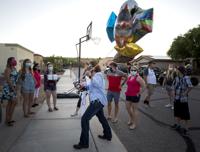
Michelle Leon Cordova, right, mother, brings celebration balloons to a car after staff members from Diamonds Children Center, friends and the Marana Police Department celebrate Sahuarita High School senior Lino Cordova, whom is fighting cancer, graduation with a car parade outside of his home on May 13, 2020 in Sahuarita, Ariz. Cordova stood on the sidewalk while the team from Diamond Children Center, friends and the Marana police department gave Cordova a graduation gar parade. Cordova was given a gift basket with his favorite snacks, gift cards as well as other items he enjoys. The car parade, also, celebrated another graduating senior fighting cancer from Empire High School, Noah Nieto. Nieto, also, received a gift basket with snacks, gift cards and other items Lino enjoys.
Tucson gets by during coronavirus pandemic
Updated
Personnel from Tucson Medical Center line the heliport to watch A-10's from Davis-Monthan Air Force Base's 355th Wing and F-16's from the Arizona Air National Guard's 162nd Wing make a pass over the facility, one leg of an area wide community flyover, May 14, 2020, Tucson, Ariz.
Tucson gets by during coronavirus pandemic
Updated
Nancy Celix-Campos, right, a respitory therapist at Tucson Medical Center, watches the military flyover with her daughters, Giana, 12, and Jazmyn, 8, from Sentinel Peak on May 14, 2020. Two F-16 Fighting Falcons from Arizona Air National GuardÕs 162nd Wing and two A-10 Thunderbolt II's from the 355th Wing, assigned to Davis-Monthan Air Force Base, fly over Tucson area hospitals to honor healthcare personnel and first responders as they are some of the frontline workers dealing with the coronavirus disease (COVID-19) head on. "It's been an exhausting two to three months," says Campos, "it's pretty cool, I like how they're going by each hospital."
Tucson gets by during coronavirus pandemic
Updated
Two F-16 Fighting Falcons from Arizona Air National Guard’s 162nd Wing and two A-10 Thunderbolt II's from the 355th Wing, assigned to Davis-Monthan Air Force Base, fly over Northwest Medical Center north of Tucson on May 14, 2020.
Tucson gets by during coronavirus pandemic
Updated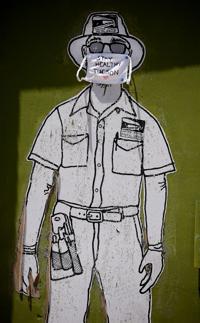
A letter carrier portrait on the Ok Market building, located in the Armory Park neighborhood, is adorned with a face mask on May 18, 2020.
Tucson gets by during coronavirus pandemic
Updated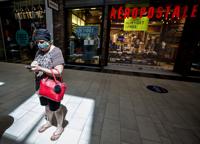
Rosemary Garcia waits for a family member outside of a store at Park Place Mall, 5870 E. Broadway Blvd., in Tucson, Ariz. on May 19, 2020. Malls reopened today under CDC guidelines and Gov. Ducey's new rules for businesses due to the Coronavirus pandemic. Park Place Mall has signs throughout the mall reminding customers to keep a six feet distance as well as hand sanitizer stations near each entrance. About half of the tables in the food court have been removed to allow for social distances as well as less than half of the stores have opened with new guidelines. Of the stores open, only 10 customers are allowed to shop in each store at a time.
Tucson gets by during coronavirus pandemic
Updated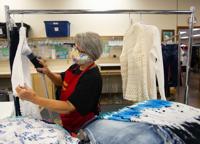
Pat Schlote steams clothing before it is put on the sales floor at the Golden Goose Thrift Shop in Catalina, Ariz., on May 21, 2020.
Tucson gets by during coronavirus pandemic
Updated
Ada Contreras, teaching assistant, looks through containers while reorganizing toys at Herencia Guadalupana Lab School, 6740 S. in Tucson, Ariz. on May 21, 2020. As Child care centers begin to re-open when they are ready, Herencia Guadalupana Lab School is reorganizing and cleaning everything in the facility before re-opening on June 2. To allow for social distancing and decrease the amount of items children touch, Herencia Guadalupana Lab School has sheds where items will go as well as placing items in containers organized by category.
Tucson gets by during coronavirus pandemic
Updated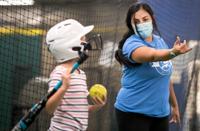
Jen Martinez, right, softball coach, teaches Skylar Reilly about hitting during a session at Centerfield Baseball Academy, 5120 S. Julian Dr., in Tucson, Ariz. on May 21, 2020. After re-opening on Monday, Centerfield Baseball Academy has implemented new policies in response to the Coronavirus Pandemic such as wearing masks, cleaning, signage, hand sanitizer and limiting the amount of people inside the facility.
Tucson gets by during coronavirus pandemic
Updated
Karl Bosma, left, and George Cantua, with facilities and maintenance, lay down stickers to mark six-foot separation distance around one of the baggage carousels, part of the efforts at Tucson International Airport to work within the restrictions of COVID19, May 22, 2020, Tucson, Ariz.
Tucson gets by during coronavirus pandemic
Updated
A lone passenger waits for a flight near one of the shuttered restaurants in the B Gates before Memorial Day at Tucson International Airport on May 22, 2020.
Tucson gets by during coronavirus pandemic
Updated
Drew Cooper on the stage in the St. Philip's Plaza courtyard, May 22, 2020, Tucson, Ariz., where live music is back on the schedule.
Tucson gets by during coronavirus pandemic
Updated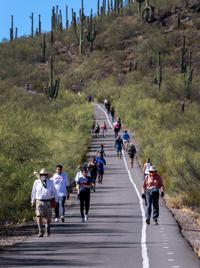
Many people visit Tumamoc Hill during the first day of Tumamoc's re-opening in Tucson, Ariz. on May 25, 2020. After being closed due to the Coronavirus pandemic, Tumamoc Hill re-opened with some modifications. There are hand sanitizer stations throughout the hike to the top as well as arrows, spaced 10-ft apart, lined up and down the hill. Some runners, hikers and walkers are also wearing masks during their hike. "The steps we are taking aim to provide our community with needed exercise, connection to our beautiful desert and a sense of comfort in such a trying time, while balancing the fact that gathering as a community endangers each of us and our loved ones. This is an unprecedented challenge that we are taking extremely seriously," said Benjamin T. Wilder, director of Tumamoc Hill. Visitors are also asked to limit their group to three people and to not touch the gate at the top of the hill- a tradition for some who make it to the top. "This is a time when we need to establish new traditions and adapt in a creative manner that embraces empathy, unity, care and patience," Wilder said.
Tucson gets by during coronavirus pandemic
Updated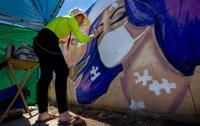
Pen Macias, artist, works on part 2 of a mural for a client on E. Broadway Rd., between S. Columbus Blvd. and S. Alvernon Way, in Tucson, Ariz. on May 25, 2020. Macias, known as The Desert Pen, has been working on her clients mural for the past three months. "It's the one thing I love, I have a passion for and the only thing I could be happy doing," said Macias. The mural represents her client, a single mother of four who works in the health care field. One half of the mural is dedicated to the connection between mothers and their children. The other half is dedicated to the connection between nurses and patients. The client wanted some positivity in the mural to show how nurses give a piece of themselves to their patients hence the puzzle pieces in the nurse and the patients, said Macias.
Tucson gets by during coronavirus pandemic
Updated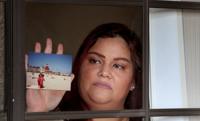
Christina Cortinas, posing at her home, May 28, 2020, Tucson, Ariz., with a photo of her and her mother, Catherine Rodriguez, in San Diego, 1991. Rodriguez is currently in assisted living and fighting COVID19. Cortinas hasn't seen her mother in months, the longest such span in her life.
Tucson gets by during coronavirus pandemic
Updated
Ruben Lopez looks through handouts while attending a Eviction Resource Fair with his family outside the Pima County Justice Court.



